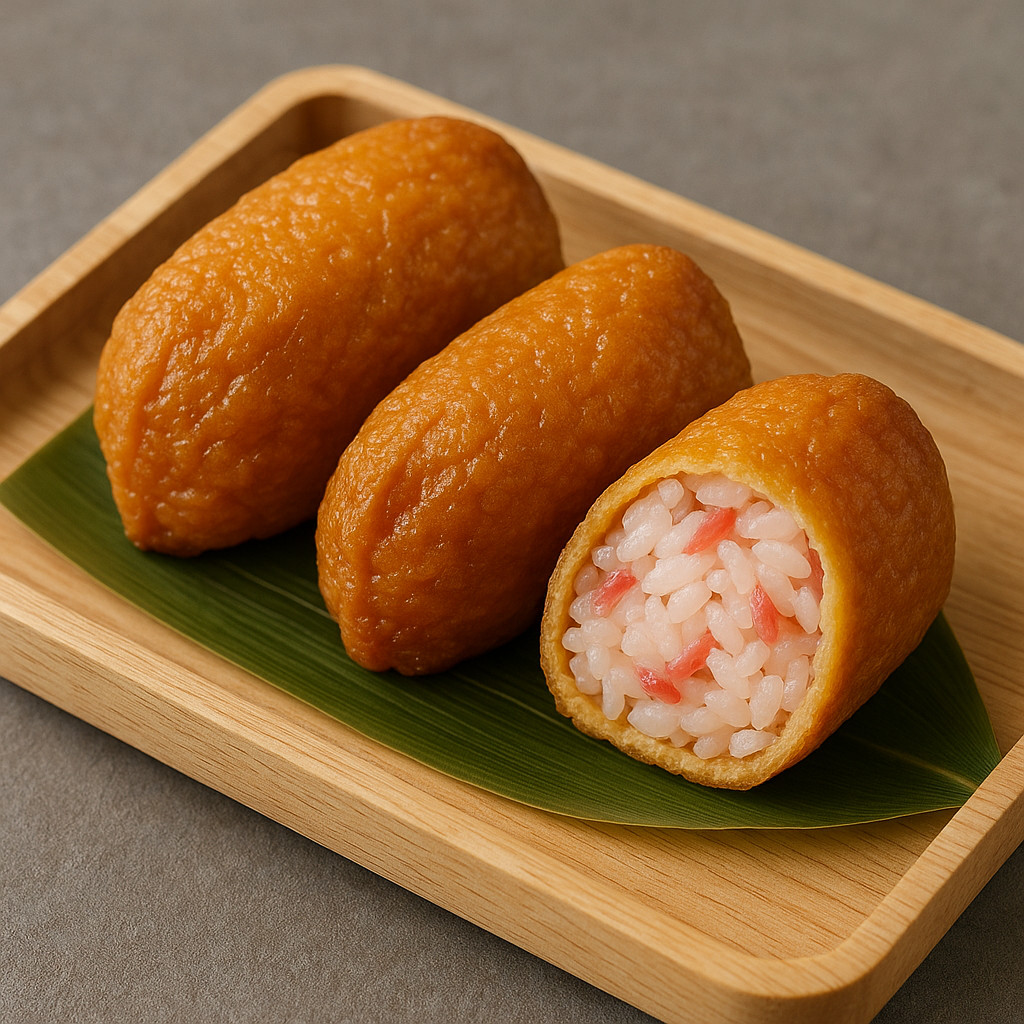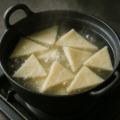いなりずし(青森)の特徴
紅しょうがで色づけした、津軽の“甘口いなり”
津軽地方のいなりずしは、刻んだ紅しょうがを混ぜたピンク色のご飯が特徴。ご飯はもち米100%(うるち米を少量混ぜる場合も)で、砂糖をしっかり利かせた甘口仕立て。おはぎのようなもっちり感と、甘辛い油揚げのコントラストを楽しみます。
“赤”と“甘さ”に込めたハレの心
赤い色は縁起の良さを表し、砂糖を惜しまず使う甘い味はおもてなしの気持ちのあらわれ。砂糖が貴重だった時代の食習慣が今も受け継がれています。
行事・持ち寄りで親しまれる定番
冠婚葬祭や地域の運動会、花見、神楽などの行事弁当に重宝。片手で食べやすく、くるみを混ぜる家もあります。
いなりずし(青森)のレシピ
材料(10個分)
- もち米 … 約2合(300g)
- 水 … 400ml
- 紅しょうが … 50g(粗みじん)
- いなり揚げ … 5枚(半分に切って10枚分に)
調味料
- [A]酢 … 大さじ2
- [A]砂糖 … 40g
- [B]水 … 1カップ
- [B]砂糖 … 30g
- [B]醤油 … 大さじ1と1/2
作り方
- もち米は洗って一晩浸水する。
- [A]を混ぜて合わせ酢を作る。紅しょうがは粗みじん。
- いなり揚げは菜箸で転がして開きやすくし、半分に切って湯通し(油抜き)。
- 鍋に[B]といなり揚げを入れてやや強火にかけ、焦がさないよう汁気がなくなるまで煮含め、そのまま冷ます。
- もち米はやや柔らかめに炊き、熱いうちに合わせ酢と紅しょうがを加えて混ぜ、蓋をして少し蒸らす。
- 酢飯を10等分して俵形にし、いなり揚げに詰める(角までしっかり詰める)。
シェフのワンポイントアドバイス
油揚げは煮てから冷ます過程で味がよく入ります。詰める直前に軽く絞って汁気を調整。
酢飯はやや柔らかめ+甘めが青森流の雰囲気に近づきます。
お弁当や冷蔵庫にて保存する場合には砂糖と醤油をやや強めにすると、冷めても味がぼけません。
栄養価(1個の目安)
- エネルギー:約180〜220 kcal
- たんぱく質:4〜6 g/脂質:6〜9 g/炭水化物:27〜33 g
冷めてもおいしく、行事や行楽の携行食に向きます。
歴史
津軽の米文化と“甘口いなり”
津軽は古くから米作が盛ん。当地のいなりずしは紅しょうがで色づけしたもち米ご飯と甘い味付けが大きな特徴です。
行事弁当としての定着
冠婚葬祭や地域の集まりの“持ち寄り”として広く定着し、今もスーパーや道の駅の惣菜でも手に入ります。
English Version
Features of Inari-zushi (Aomori)
Tsugaru’s “sweet inari” with pink rice tinted by red ginger
In Tsugaru, inari-zushi is distinguished by pink-tinted rice mixed with chopped red pickled ginger. The rice is typically 100% glutinous (mochi) rice (some homes mix in a little regular rice) and is seasoned on the sweet side. Enjoy the mochi-like chew against the sweet–savory fried tofu pouches.
Festive meanings in “red” and “sweetness”
The red hue symbolizes good fortune, while the generous sweetness expresses hospitality. The practice harks back to times when sugar was precious.
A potluck staple for events
Perfect for weddings and funerals, school sports days, cherry-blossom viewing, and village festivals. Easy to eat by hand—some families also mix in chopped walnuts.
Recipe
Ingredients (10 pieces)
- Glutinous (mochi) rice … about 2 cups / 300 g
- Water … 400 ml
- Red pickled ginger … 50 g (roughly minced)
- Abura-age (fried tofu pouches) … 5 sheets (halved to make 10)
Seasonings
- [A] Vinegar … 2 tbsp
- [A] Sugar … 40 g
- [B] Water … 1 cup
- [B] Sugar … 30 g
- [B] Soy sauce … 1½ tbsp
Instructions
- Rinse the glutinous rice and soak overnight.
- Mix [A] to make the sushi vinegar. Roughly mince the red ginger.
- Roll each abura-age with chopsticks to loosen, cut in half, then blanch to remove excess oil.
- In a pot, simmer [B] with the abura-age over slightly high heat until the liquid is nearly gone. Let cool in the remaining liquid.
- Cook the glutinous rice slightly soft. While hot, fold in the sushi vinegar and red ginger, cover, and steam briefly.
- Divide the rice into 10 ovals and pack into the pouches, pressing into the corners.
Chef’s Tips
The pouches absorb flavor as they cool after simmering; just before filling, lightly squeeze to adjust moisture. A slightly soft, sweet rice profile matches the Tsugaru style. For bento or refrigeration, use a touch more sugar and soy so the flavor stays clear when cold.
Nutritional Value (per piece, approx.)
- Calories: 180–220 kcal
- Protein: 4–6 g / Fat: 6–9 g / Carbohydrates: 27–33 g
Tastes great even when cooled—ideal for events and outings.
History
Tsugaru rice culture and the “sweet inari” tradition
Tsugaru has long been a rice-growing area. Here, inari-zushi is defined by its pink, ginger-tinted mochi rice and sweet seasoning.
Established as an event bento
Widely made for communal gatherings and potlucks, and still found as a deli item at supermarkets and roadside stations.



何でも質問してください!